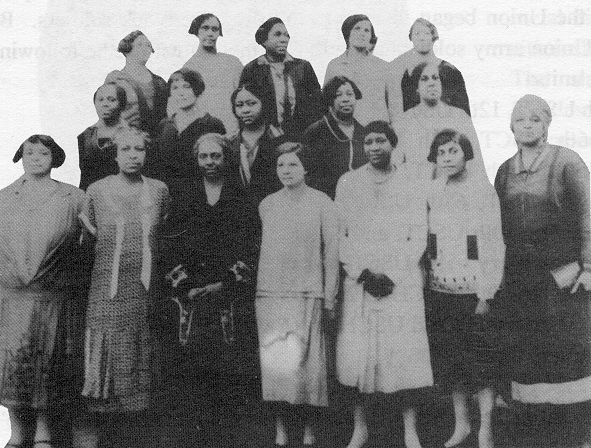 The
Blue Triangle League of the Young Women's Christian Association ('YWCA)
opened its doors to black girls and women in Nashville on June 1, 1919,
in the Napier Court Building at 411 Fourth Avenue, North. The nucleus of
the Blue Triangle League came from black women who were members of the
Fireside School, a group that meet regularly for Bible Study and to make
items needed by the black soldiers of World War I. Mrs. Arch Trawick of
the Central (white) YWCA and director of the Southeastern Region of the
War Work Council, a national organization for women during the war under
the direction of the National YWCA, secured $2,000 for the League s operation.
Negro women raised $1,000 through Blue Triangle memberships, block parties,
and other entertainment to establish the program to assist young women
employed in war industries and conduct recreational activities near soldiers'
camps. The committee on management became a permanent organization, with
Marian Hadley as paid secretary and J. F. Pierce as committee chairperson.
Classes and recreational programs were held at local colleges,, Bethlehem
House, Hadley Park, and on private lawns.
The
Blue Triangle League of the Young Women's Christian Association ('YWCA)
opened its doors to black girls and women in Nashville on June 1, 1919,
in the Napier Court Building at 411 Fourth Avenue, North. The nucleus of
the Blue Triangle League came from black women who were members of the
Fireside School, a group that meet regularly for Bible Study and to make
items needed by the black soldiers of World War I. Mrs. Arch Trawick of
the Central (white) YWCA and director of the Southeastern Region of the
War Work Council, a national organization for women during the war under
the direction of the National YWCA, secured $2,000 for the League s operation.
Negro women raised $1,000 through Blue Triangle memberships, block parties,
and other entertainment to establish the program to assist young women
employed in war industries and conduct recreational activities near soldiers'
camps. The committee on management became a permanent organization, with
Marian Hadley as paid secretary and J. F. Pierce as committee chairperson.
Classes and recreational programs were held at local colleges,, Bethlehem
House, Hadley Park, and on private lawns.
In November of 1920, a three-story residence at 436 Fifth Avenue, North (where the Municipal Auditorium now stands), was purchased. The First floor had one large room for meetings, special affairs, offices, kitchen, and restrooms. The other floors included living space for newly arrived working women. Within seven years, the mortgage was paid on this property. The Blue Triangle Branch's programs included residence for young single women, full Girl Reserve (later called Y-Teens), camping, USO activities, employment services, religious vespers, business and professional clubs, forums, BHW clubs, industrial clubs, interracial committees, leadership training classes, typing, and shorthand classes.
In 1953, a new building was constructed at 1708 Pearl Street, following a successful capital fund drive. Mrs. Maxey Jarman chaired the Central YWCA, and Mrs. D. H. Turpin headed the Blue Triangle. The goal was $65,000 to be raised by the Central YWCA and $25,000 by the Blue Triangle Branch. Dedication Ceremonies were held on October 25, 1953, when Ceceila N. Adkins chaired the Triangle. All the rooms were furnished by local sororities, clubs, and Blue Triangle Branch committees. The new building became an active center, where women and girls taxed the facility's capacity. A register of approved homes was kept on hand because white hotels, motels, and even the Central YWCA practiced racial segregation.
Some of the popular classes at the Blue Triangle Branch included drapery and upholstery, sewing, tailoring, typing, slimnastics, culinary art, hat-making, flower-arrangement, bridge, adult literacy, and special forums. Additionally, the Blue Triangle's Y-Teen program enriched the lives of many black girls at local schools. The faculty of these schools cooperated and served as advisors to help give the girls leadership skills, moral values, camping experiences, and the opportunity to travel and attend YWCA conferences.
During the 1950s and 1960s, the branch facilities were available to the total community. Then, in the midst of the civil rights struggle, the YWCA experienced difficulties in race relations when black applicants for housing were refused admittance. Consequently, the Nashville YWCA's board of directors voted in 1963 to add selected black members of the Blue Triangle to its membership. These first local YWCA board members included Mary D. Shane, Anna G. Sasser, and Carrie R. Hull. The Blue Triangle became known as the Pearl Street Center in 1969., This center closed in 1974, and the facility was sold to the Grace M. Eaton Day Home.